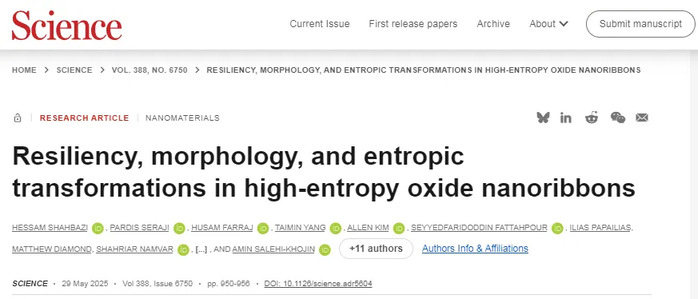On May 29, a groundbreaking study led by Professor Huang Zhehao's team from the School of Emergent Soft Matter and the Electron Microscopy Center at South China University of Technology (SCUT), in collaboration with international researchers, was published in the prestigious journal Science. This landmark achievement represents the world's first successful synthesis of one-dimensional high-entropy oxides (1D-HEO) with unique nanoband morphology.
The newly developed material demonstrates exceptional stability under extreme conditions, maintaining its structural integrity in ultra-high temperature, high-pressure, and strongly acidic or alkaline environments. Moreover, it exhibits superior mechanical properties that significantly outperform conventional materials, opening new possibilities for applications in demanding industrial and scientific fields.

A Five-Year Interdisciplinary Breakthrough: Decoding the Atomic Secrets of Ultra-Stable High-Entropy Oxides
This landmark study represents the culmination of nearly five years of pioneering research, uniting diverse fields—from materials science to nanotechnology—to tackle one of the most persistent challenges in the field: resolving the precise crystal structure of a one-dimensional high-entropy oxide (1D-HEO) with intricate composition and unconventional morphology.
To achieve this unprecedented feat, the team revolutionized nanocrystal analysis by pioneering the application of three-dimensional electron diffraction (3D-ED). This cutting-edge approach enabled three key breakthroughs: atomic-scale resolution of the nanoribbon’s crystal structure, uncovering critical microstructural traits such as preferential orientation, growth surface dynamics, and oxygen vacancy distribution, and deciphering temperature-driven structural evolution to reveal fundamental transformation mechanisms. Together, these advances provide the first comprehensive atomic-level understanding of this ultra-stable 1D-HEO system.
These insights not only provide a fundamental understanding of the material’s exceptional stability but also reveal its phase transition mechanisms—advancing knowledge beyond structural design into the realm of dynamic material behavior under extreme conditions.

Professor Huang Zhehao, School of Emergent Soft Matter
Controlled Synthesis and Structural Characterization of 1D High-Entropy Oxide Nanoribbons
This study achieved the controlled synthesis of 1D high-entropy oxide (1D-HEO) nanoribbons through programmed elevated-temperature oxidation of a hexagonal-phase multicomponent sulfide precursor, (MoWNbTaV)S₂.
Morphological and Structural Evolution
Scanning electron microscopy (SEM) and energy-dispersive spectroscopy (EDS) confirmed uniform elemental distribution and ribbon-like morphology (Figs. 1A–1H).
X-ray diffraction (XRD) and Wulff construction simulations revealed that nanoribbon growth orientation is governed by attachment energy, favoring elongation along specific crystallographic planes (Figs. 1I–1N).
By precisely tuning reaction temperature and heating rate, the team achieved width control across two orders of magnitude (60 nm to 15 μm), enabling tailored design of low-dimensional high-entropy structures (Figs. 2A–2C).
Atomic-Scale Insights via 3D Electron Diffraction (3DED)
The study leveraged 3DED—a breakthrough technique for nanoscale crystallography—to resolve the material’s atomic structure:
Crystal system determination: Combined with HAADF-STEM imaging (Fig. 2F), 3DED identified 1D-HEO as an orthorhombic phase (P2₁2₁2) and precisely mapped its unit cell parameters and growth axis (Fig. 2G).
Oxygen vacancy analysis: 3DED uniquely resolved the oxygen vacancy distribution, crystallographic orientation, and local coordination environment, revealing that the structure remains highly ordered below 700°C with only minor oxygen occupancy fluctuations—a feat unattainable via conventional bulk XRD (Figs. 3A–3C).
Exceptional Stability and Mechanical Performance
1D-HEO exhibits unparalleled stability under extreme conditions:
Thermal resilience: No mass loss or phase changes at 1000°C (thermogravimetric analysis, Fig. 3A; in situ XRD, Fig. 3B). Atomic-level stability was confirmed by near-identical 3DED patterns at room temperature and high temperature (Fig. 3C).
Chemical inertness: After 7 days in strong acid (pH 2.3) and alkali (pH 13), no degradation was detected by XRD, XPS, or SEM-EDS (Fig. 3D). ICP-MS measured negligible metal ion leaching, further validating corrosion resistance.
Mechanical superiority: Nanoindentation tests demonstrated a hardness of 6.89 GPa—surpassing aerospace alloys (IN718, Ti-6Al-4V, GRCop-84)—and an elastic recovery modulus of 40 MJ/m³ (20× higher than GRCop-84) (Figs. 3E–3F). DFT calculations attributed this to the material’s mixed ionic-covalent bonding network.
Pressure-Induced Phase Transitions and Entropic Effects
Under 30 GPa compression, 1D-HEO undergoes a sequential transformation:
Orthorhombic → cubic → amorphous, accompanied by abrupt volume collapse and loss of long-range order (Figs. 4A–4C).
Non-hydrostatic/uniaxial stress alters phase transition pathways and optical properties (Figs. 4D–4E), highlighting stress-field-dependent structural evolution.
These findings reveal a novel entropy contribution during compression, expanding high-entropy material theory beyond conventional frameworks.





